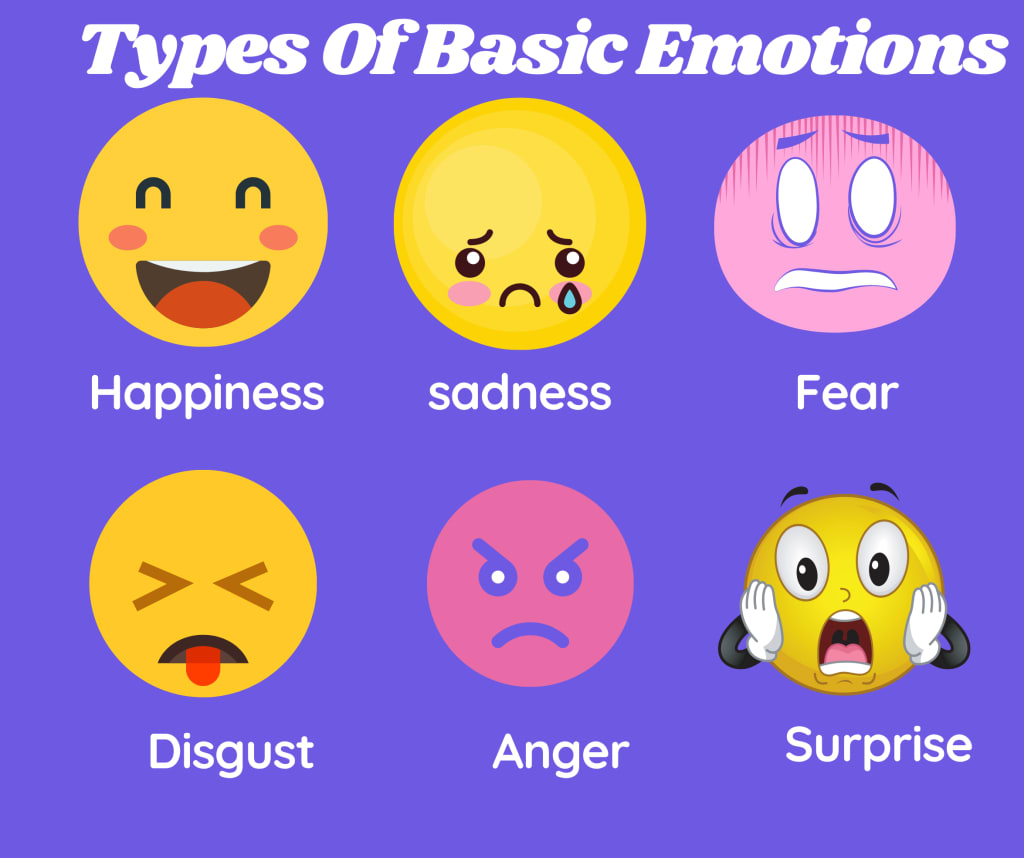The 6 Types of Basic Emotions
Their Effect on Human Behavior

There are many types of emotions that influence how we live and interact with others. At times, it may seem like these emotions rule us. The choices we make, the actions we take, and the perceptions we have are all influenced by our emotions at any given moment.
Psychologists have also tried to identify the different types of emotions that people experience. A few other theories have emerged to categorize and explain the emotions that people feel.
Basic emotions
During the 1970s, psychologist Paul Ekman identified six basic emotions that he suggested were universally experienced in all human cultures. The emotions he identified were happiness, sadness, disgust, fear, surprise, and anger. He later expanded his raw emotions list to include pride, shame, embarrassment, and excitement.
Combining emotions
Psychologist Robert Plutchik places forth a “wheel of emotions” that worked something like the color wheel. Emotions can be combined to form very different emotions, just like colors can be mixed to create other tones.
According to this theory, the more thoughts that are fundamental, something similar to building obstructs.
More complicated, sometimes mixed emotions, are blendings of more people, which can be fundamental. For instance, fundamental thoughts such as joy and trust are combined to produce love.
A 2017 research implies that we now have far more emotions than are basically previously thought. In the scholarly research posted in Proceedings of the nationwide Academy of Sciences, researchers identified 27 different feelings.
However, the researchers discovered that people encounter these emotions along a gradient as opposed to being entirely distinct.
Let’s have a better appearance at some fundamental types of emotions and explore the impact they have actually on human behavior.
Happiness
Of all the different kinds of feelings, happiness tends to end up being how people focus on the many. Happiness is usually defined as being pleasant declare that it is psychological is seen as a feeling of contentment, joy, gratification, satisfaction, and wellbeing.
Research on happiness has increased significantly since the 1960s within a genuine amount of procedures, like the branch of psychology referred to as positive psychology. This type of feeling may also be expressed through:
Facial expressions: for instance, smiling.
Gestures: such as being in a relaxed stance.
The tone of voice: a positive, pleasant means of speaking.
The things we think will generate happiness tend to become significantly affected by culture, while happiness is recognized as one of the primary individual emotions.
For example, pop culture influences emphasize that attaining particular things such as purchasing a house or having work that is high-paying leads to happiness.
The realities of what plays a part in happiness are frequently significantly more complex. Individuals have very long believed that happiness and wellness were linked.
Research has supported the indisputable fact that happiness can play a role in both physical and health that is psychological.
Happiness was associated with an assortment of results, including increased longevity and increased satisfaction. unhappiness happens to be associated with many bad wellness results.
Stress, anxiety, depression, and loneliness, as an example, are connected to things such as lowered immunity, increased inflammation, and decreased life expectancy.
Sadness
Sadness is a different type of emotion frequently thought of as a transient state that is emotional by disappointment, grief, hopelessness, disinterest, and dampened the mood.
Like other emotions, sadness is a thing that all social individuals experience every so often. In certain full instances, individuals can experience severe and prolonged durations of sorrow that may turn into despair. Sadness can be expressed in a real range means including:
- crying
- Dampened mood
- Lethargy
- Quietness
- Withdrawal from others
The kind and severity of sadness can differ depending upon the leading cause, and strictly how people deal with such emotions can vary as well.
Sadness can frequently lead individuals to participate in coping mechanisms such as avoiding other folks, self-medicating, and ruminating on negative thoughts. Such behaviors can exacerbate emotions of real sadness and prolong the duration of the emotion.
Fear
Fear is a powerful emotion that also can play a crucial role in success. You undergo what’s referred to as a fight-or-flight response once you face danger and experience fear.
Your muscles become tense, your heart respiration and rate enhance, along your mind become more alert, priming the body to either run through the risk or stay and fight.
This response helps to ensure that you’re prepared to cope with threats in your environment effortlessly. Expressions of this kind of feeling can consist of:
Facial expressions: such as widening the optical eyes and pulling back the chin
Gestures: efforts to conceal or flee through the threat
Physiological responses: such as instance rapid heartbeat and respiration
Of course, not everybody else experiences fear in the same manner. Some individuals may be much more delicate to fear, and situations that are particular objects may become more likely to trigger this feeling.
Fear could be the emotional reaction to a threat that is immediate. We can also produce an effect similar to common threats and our thoughts about potential hazards, which is precisely what we generally think of as anxiety. Personal anxiety, as an example, involves a fear that is anticipated in situations.
Some individuals, on the other side, actually look for situations being fear-provoking. Extreme sports, as well as other thrills, can be fear-inducing; many people seem to flourish and also enjoy such feelings.
Repeated contact with a fear item or situation can cause acclimation and familiarity, which may reduce emotions of fear and anxiety.
This is the concept behind exposure therapy, in which folks are gradually confronted with the items that frighten them in a controlled and manner that is safe. Eventually, emotions of fear start to decrease.
Disgust
Disgust is another of the first six emotions that are fundamental by Eckman. Disgust can be displayed in a real number of ways, including:
Body language: turning far from the object of disgust
Real reactions: such as retching or vomiting
Facial expressions: as wrinkling the nose and curling the upper lip
This feeling of disgust can originate from several things, including a flavor that is an unpleasant sight or scent. Researchers think that this emotion developed as an effect on meals that may be fatal or harmful.
Whenever individuals smell or taste meals that went bad, for instance, disgust is a typical response.
Poor hygiene, infection, blood, rot, and death also can trigger a reply that is disgust. This can be the human body’s method of avoiding things that could carry transmittable diseases.
People may also experience ethical disgust they observe others doing actions that they find distasteful, immoral, or wicked.
Anger
Anger can be considered a feeling that is particularly effective by emotions of hostility, agitation, frustration, and antagonism towards other people. Like fear, anger can play a right component in your human anatomy’s fight-or-flight response.
Whenever a danger generates feelings of anger, you may be inclined to fend the threat down and protect yourself. Anger can be displayed through:
Facial expressions: such as glaring or frowning
Gestures: such as taking a stance that is strong, switching away
Words: such as speaking gruffly or yelling
Physiological reactions: such as example turning or sweating red
Aggressive habits: such as hitting, kicking, or objects being thrown.
While anger is often regarded as a low emotion, it can occasionally be considered a great thing. It may be constructive in helping explain your preferences in a relationship.
Also, it also can inspire you to take action and discover solutions to things that are bothering you.
Anger becomes a nagging problem; however, it is excessive or expressed in many ways, which can be unhealthy, dangerous, or damaging to others. Uncontrolled anger can turn to aggression quickly, abuse, or violence.
This sort of feeling can have both mental and consequences that are real.
Unchecked anger makes it difficult to make choices that can be rational can have an effect on your own physical health.
Anger is connected to the coronary heart and diabetes. It’s additionally been related to behaviors that pose health dangers such as aggressive driving, alcohol consumption, and smoking cigarettes.
Surprise
Surprise is another of the six fundamental kinds of human being emotions initially described by Eckman. Shock is usually relatively brief, and it is characterized by a physiological reaction that startles one thing unexpectedly.
These kinds of emotions are positive, negative, or neutral.
An unpleasant surprise, as an example, might include someone jumping down from behind a tree and scaring you as you walk to your car in the evening.
An excellent example of a pleasant shock is arriving at the house to realize that your closest buddies have gathered to celebrate your birthday celebration. Shock is generally seen as an:
Facial expressions: for example, raising the brows, widening the optical eyes, and opening the mouth
Real responses: such as leaping back
Spoken responses: such as yelling, screaming, or gasping
Surprise is a different type of emotion that can trigger the fight or flight response. When startled, people may experience a burst of adrenaline that can help prepare the physical human anatomy to either battle or flee.
Surprise can have effects that are essential to people’s behavior. As an example, research has shown that individuals tend to notice surprising events disproportionately.
That is why surprising and events that can be unusual news tend to get noticed in memory more than others.
Research has additionally found that individuals are more swayed by astonishing arguments and learn more from surprising information.
Other Types of Emotions
The six emotions which are fundamental by Eckman are only a portion of many several types of emotions that psychologists are designed for experiencing. Eckman’s theory suggests that these core emotions are universal throughout countries all over the planet.
Nevertheless, other theories and research that is new to explore the various sorts of emotions and how they are categorized. Eckman later added a correct number of different feelings to their list but suggested that unlike their original six emotions, not absolutely all of these could necessarily be encoded through facial expressions.
A few of the feelings he later identified included: Entertainment
- Contempt
- Contentment
- Embarrassment
- Excitement
- Guilt
- Pride in achievement
- Relief
- Satisfaction
- Pity
About the Creator
Fahim Chughtai
Mental Health, Personal growth, Relationships.






Comments
There are no comments for this story
Be the first to respond and start the conversation.